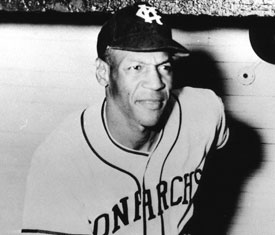a little bit of pro bono work
- January 7th, 2014
- Posted in random coolness
- Write comment
The last few days, I’ve been working on recovering some recordings of a ten year old interview with Buck O’Neil, of the Kansas City Monarchs of the old Negro American League, during segregation. He lead the effort to establish the Negro Leagues Baseball Museum, and has several other firsts; Ken Burns used him quite a bit in his documentary on baseball.
The recordings were made on a pocket microcassette recorder, ten years ago. I don’t know if you’ve ever seen one of these things, but they were one of the smallest tape factors ever made, moved really slowly, and did not age well.
Even optimally, they could record about 50hz to 4000hz – less than a fifth the range of modern equipment – and are prone to noise, hiss, and other problems, all of which this recording had. Plus, the recording was made handheld, via a PA, which itself had feedback issues causing ringing on emphasised words, all at highly variable signal levels.
So it’s been quite a learning experience. Knowing much more about this from theory than practice, I was glad to get a chance to try out some of these tricks.
I used a repetitive-noise pattern-matching filter to etch out the worst of the repeating noise profile. Then a low pass filter to get rid of everything above 4000hz and a high-pass filter to get rid of everything below 50hz; since those are beyond the capability of the format, anything in those regions was playback harmonics or noise.
Then a collection of notch filters to get rid of primary feedback tone and two common harmonics of it, variable-band equalisation filters to duck out what I could of the recorder’s noise and some in-room sound, and some very careful but high-ratio compression to bring it all to a vaguely consistent level. In some areas, this exposed or exaggerated sibilants, which I filtered out. Then I threw on (in some places) a tiny touch of reverb to hide the worst of the tape-jitter distortion and make it all understandable, followed by a final equalisation round to try to throw a little life back into it, and another round of compression.
The result isn’t something I’d call good – you can’t get there from here – but it’s reasonably clear, has a lot less noise, and listenable, whereas the originals range between better than you’d expect and inaudible, with a deeply fatiguing feedback ring.
I may be able to link to the result, eventually. If you get a chance to hear a recording of Buck O’Neil at one of these sorts of events, you should; he’s got a million stories from segregation and baseball, and they’re all interesting.



Ever hear of Rim Drive cassettes? kinda like Microcassette-a tiny tape cassette slightly smaller than a microcassette, that quickly became an “orphan” format back in the mid 1980s. I had gotten one as a birthday present, and used it to record family history/stories with, as told by my grandparents and others. The unit was cheesy at best, the drive made up of brittle white plastic that gave up quickly.
I still have the tapes ( I think), but it’s rare to find someone that’s even heard of Rim Drive, much less find a functioning unit.
Thanks again for this. It was interesting to read your perspective on the project itself along with the inherent limitations of the source material.
Whether it’s via something through the NLBM (I don’t know if there would be plans to have it online or just at the museum itself) or otherwise, I can absolutely make the audio available to anyone who’d like to hear it, whether for the stories, the work you did on it, or both.
@Scott: There have been several rim-drive systems, but … I don’t think so. I remember a rim-drive reel-to-reel system, but I don’t think cassette. Got photos? Those old system things are interesting.
@James V.: You have a taker over on Facebook – a fan of early Baseball and in particular the Negro Leagues; I’ve pointed her at you.
And glad to do it – it was interesting, and a chance to use some theory!
5 comments at Facebook; 3 comments on Livejournal.
@solarbird
Seen, thanks.